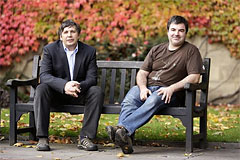Einstein’s famous E=mc2 equation and the Large Hadron Collider to recreate a miniature version of the event at the origins of our Universe, and the first findings from their work were published in the journal Physical Review Letters.
Dr. Andreas Warburton of McGill’s Department of Physics made leading contributions to the analysis of data from the experiment, known as “ATLAS,” meaning the findings have a special significance for Canadian science.
Warburton and 3171 colleagues from around the world are using the data collected from the recreation in an attempt to look for exotic new particles whose existence is suggested by theoretical calculations. His work may help to revolutionize our understanding of the fundamental components of the Universe.
“Understanding whether new kinds of matter exist or not is interesting because it holds clues to knowledge about how the Universe works fundamentally,” Warburton said. “The Standard Model of Particle Physics is a useful theoretical framework but it is known to be flawed and incomplete — we are searching for new particles that lie outside this framework, and we are also seeking to establish the non-existence of these hypothetical particles.” The research published this week falls into the latter category and is about determining the mass of a theoretical particle known as an “excited quark.”
Warburton offered the following analogy: “By exploring the high-energy subatomic frontier, it is metaphorically somewhat like turning over stones at the seashore and looking for new and interesting surprises hiding under the rocks. Here we are looking under stones that have been too heavy to lift before this summer. What we see or don’t see under those stones helps to paint new pictures about how the Universe works and tells us which stones are most important to look under next.”

